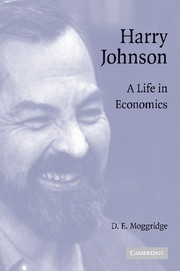Book contents
- Frontmatter
- Contents
- Photographs and Drawings
- HARRY JOHNSON
- Introduction
- 1 Toronto
- 2 Antigonish
- 3 England
- 4 North American Postgraduate
- 5 Cambridge Don
- 6 Cambridge Economist
- 7 Manchester
- 8 Chicago
- 9 Canada, Economic Nationalism, and Opulence, 1957–1966
- 10 Chicago: Money, Trade, and Development
- 11 LSE
- 12 Professional Life – Largely British
- 13 Money and Inflation
- 14 The International Monetary System
- 15 Harry's “Wicksell Period”
- 16 Stroke and After
- 17 Conclusion
- Sources
- Index
- Plate section
4 - North American Postgraduate
Published online by Cambridge University Press: 04 December 2009
- Frontmatter
- Contents
- Photographs and Drawings
- HARRY JOHNSON
- Introduction
- 1 Toronto
- 2 Antigonish
- 3 England
- 4 North American Postgraduate
- 5 Cambridge Don
- 6 Cambridge Economist
- 7 Manchester
- 8 Chicago
- 9 Canada, Economic Nationalism, and Opulence, 1957–1966
- 10 Chicago: Money, Trade, and Development
- 11 LSE
- 12 Professional Life – Largely British
- 13 Money and Inflation
- 14 The International Monetary System
- 15 Harry's “Wicksell Period”
- 16 Stroke and After
- 17 Conclusion
- Sources
- Index
- Plate section
Summary
Toronto Instructor
The University of Toronto, where classes began on 24 September 1946, was a very different institution from the one Harry had left for Antigonish just three years earlier. In 1943 total enrolment had been under 7,000; in 1946 it was 17,173, up from 12,515 the previous year. Of the 17,173, no fewer than 8,723 were veterans. In the Department of Political Economy, undergraduate enrolments had grown from 1,534 – of whom 35 were taking more than three courses in the fourth year of Political Science and Economics or Commerce and Finance – to 6,787 – of whom 101 were taking more than three fourth-year courses. Part of the expansion was in the service course for engineers, where enrolments went from 300 to 2,160. Enrolment in economics would peak at 8,800 in 1947–8. Graduate school enrolment had also exploded – and the graduate students were needed as teaching assistants, whose numbers had risen in the department from six to forty-eight. Although the department's faculty had grown since 1943 from twenty-one to forty-four, the long-term, full-time staff had only risen to replace wartime losses. All the expansion in numbers had occurred in the ranks of lecturer and instructor (Harry's rank). Instructors were virtually unknown before the war, but they numbered four in 1943–4 and fifteen in 1946–7. There would be only three in that rank in 1951–2 (Drummond 1983, 97).
With increased numbers of students and faculty, the department's building on Bloor Street was bulging at the seams.
- Type
- Chapter
- Information
- Harry JohnsonA Life in Economics, pp. 73 - 92Publisher: Cambridge University PressPrint publication year: 2008

